Il ramen è molto più di una semplice zuppa di noodles; è un universo di sapori complessi, orgoglio regionale e arte culinaria. Dai brodi densi e torbidi di Fukuoka alle zuppe chiare e delicate di Tokyo, ogni ciotola racconta una storia unica. Comprendere i tipi di ramen fondamentali è il primo passo in un delizioso viaggio in uno dei piatti più celebrati del Giappone. Questa guida è la tua mappa per navigare in questo vasto mondo.
Ti guideremo attraverso nove stili essenziali di ramen, dettagliandone le origini distinte, i componenti principali e cosa rende ciascuno un'esperienza da provare. Imparerai a differenziare le quattro basi di sapore principali:
- Shio (sale)
- Shoyu (salsa di soia)
- Miso (pasta di soia)
- Tonkotsu (ossa di maiale)
Esploreremo anche varianti popolari come lo stile da intingere Tsukemen e il Abura Soba senza brodo. Alla fine, non solo sarai in grado di identificare con sicurezza la tua ciotola perfetta, ma apprezzerai anche il profondo patrimonio culturale che si cela in ogni cucchiaio. Preparati a immergerti nel mondo autentico del ramen giapponese, a scoprire il tuo prossimo pasto preferito e a imparare come gustarlo come un locale. Per chi è ispirato a portare questi sapori autentici a casa, ti indicheremo anche dove trovare ingredienti di alta qualità per le tue avventure culinarie.
1. Ramen Shoyu
Il ramen Shoyu è il tipo di ramen più classico e antico, offrendo un assaggio di tradizione in ogni ciotola. Originario di Tokyo, il suo tratto distintivo è un brodo chiaro e marrone che raggiunge un perfetto equilibrio tra sapido e leggero. La base della zuppa è tipicamente fatta con brodo di pollo o maiale, ma l'elemento distintivo è il tare (salsa di condimento) fatto con salsa di soia giapponese, che dà il nome al ramen ("shoyu" significa salsa di soia).
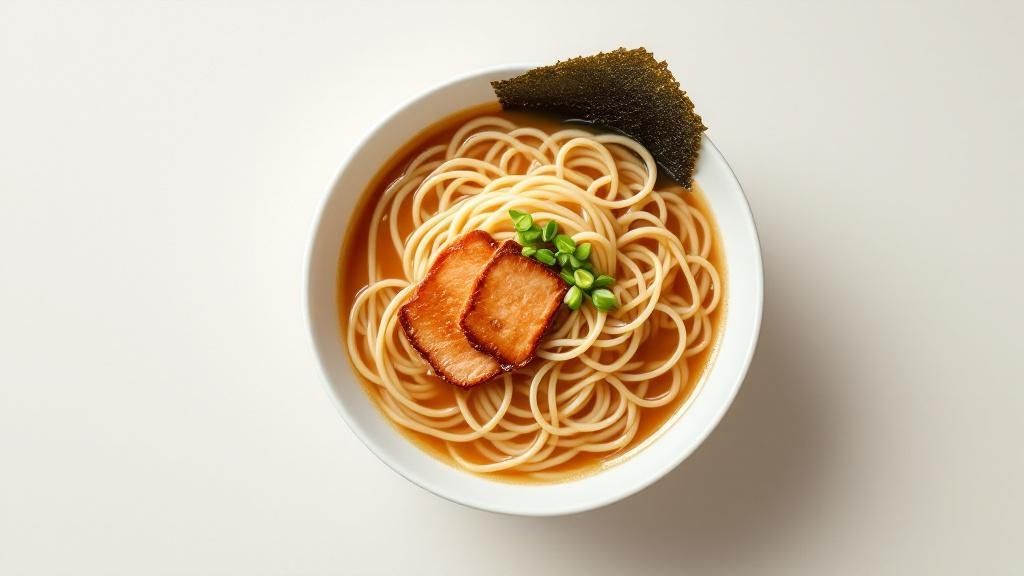
Questo stile offre un sapore complesso e ricco di umami, sofisticato ma profondamente confortante. Il suo finale pulito lo rende un favorito versatile sia tra i neofiti del ramen che tra gli appassionati esperti. L'armoniosa combinazione di ingredienti nel ramen Shoyu è un ottimo esempio dell'approccio equilibrato tipico della cucina giapponese. Puoi esplorare di più su questo argomento e scoprire cosa lo rende davvero così potente.
Caratteristiche chiave e condimenti
La bellezza del Shoyu ramen risiede nella sua elegante semplicità e nella qualità dei suoi componenti.
- Brodo: Chiaro e marrone chiaro, fatto con pollo, maiale o talvolta dashi, con un tare distintamente a base di salsa di soia.
- Tagliatelle: Tipicamente medio-sottili e ondulate, con una consistenza soda e gommosa che trattiene bene il brodo.
- Condimenti comuni: Fettine di chashu (pancia di maiale brasata), menma (germogli di bambù), cipollotti, nori (alga secca) e un uovo morbido (ajitama).
Perché è un classico
Il Shoyu ramen è la base del mondo del ramen. È lo stile che spesso viene in mente quando si pensa per la prima volta al ramen, grazie alla sua popolarità diffusa iniziata a Tokyo. Il suo fascino duraturo è consolidato da negozi leggendari come Tsuta, il primo ramen-ya a ricevere una stella Michelin, specializzato in un raffinato Shoyu ramen. Questo stile è il punto di partenza perfetto per chiunque voglia comprendere la storia e i sapori fondamentali del ramen giapponese autentico.
2. Tonkotsu Ramen
Il Tonkotsu ramen è un'esperienza ricca e decadente, famoso per il suo brodo incredibilmente corposo e opaco. Originario del quartiere Hakata di Fukuoka sull'isola di Kyushu, la sua caratteristica distintiva è una zuppa cremosa e bianco latteo fatta con ossa di maiale (tonkotsu significa "osso di maiale"). Queste ossa vengono bollite a ebollizione vigorosa per un lungo periodo, spesso da 12 a 20 ore, per rompere il midollo, il grasso e il collagene in un'emulsione profondamente saporita e lussureggiante.
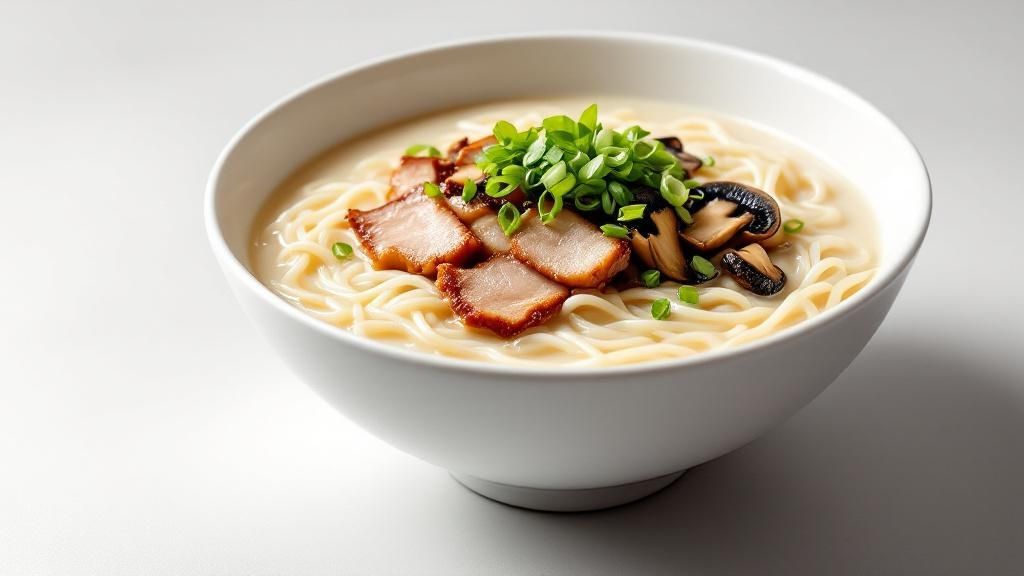
Questo stile offre un sapore intensamente di maiale, ricco di umami, con una consistenza vellutata che avvolge ogni tagliatella. La sua natura indulgente lo ha reso un fenomeno globale, celebrato per il suo carattere che riscalda l'anima e soddisfa. Pur essendo ricco, un brodo Tonkotsu ben fatto è equilibrato e non unto, rappresentando un apice dell'arte del ramen. Puoi scoprire di più su Tonkotsu e altri tipi di ramen per comprendere il suo potente fascino.
Caratteristiche chiave e condimenti
La magia del Tonkotsu ramen sta nel suo brodo che richiede molto tempo e nei condimenti che ne completano la ricchezza.
- Brodo: Cremoso, opaco e bianco latteo, con un profondo sapore saporito di maiale derivato dal collagene e dal midollo emulsionati.
- Tagliatelle: Tipicamente molto sottili, dritte e sode (katamen), progettate per essere mangiate rapidamente prima che si ammorbidiscano nel brodo denso. Molti negozi offrono la personalizzazione della durezza delle tagliatelle.
- Condimenti comuni: Fettine sottili di chashu (maiale), uovo morbido (ajitama), funghi orecchia di legno (kikurage), zenzero sottaceto (beni shoga), semi di sesamo e cipollotti tritati.
Perché è un classico
L'ascesa del ramen tonkotsu alla fama globale è una storia di successo moderna, che ne consolida il posto come uno dei tipi di ramen più amati. La sua popolarità è stata catapultata da catene internazionali come Ippudo e Ichiran, che hanno introdotto il mondo all'esperienza autentica in stile Hakata. Il brodo ricco e distintivo dello stile offre un pasto unicamente confortante e lussuoso, rendendolo una ciotola indimenticabile per chiunque cerchi un'avventura ramen davvero indulgente.
3. Ramen Miso
Il ramen miso è uno stile sostanzioso e complesso, celebrato per il suo brodo ricco e opaco e il profilo di sapore unico e robusto. Originario di Sapporo nella regione settentrionale di Hokkaido, questo ramen è nato dal desiderio di un pasto caldo e nutriente per combattere i freddi inverni. La sua caratteristica distintiva è l'uso del miso, una pasta di soia fermentata, che infonde al brodo un sapore intensamente saporito, nocciolato e leggermente dolce.
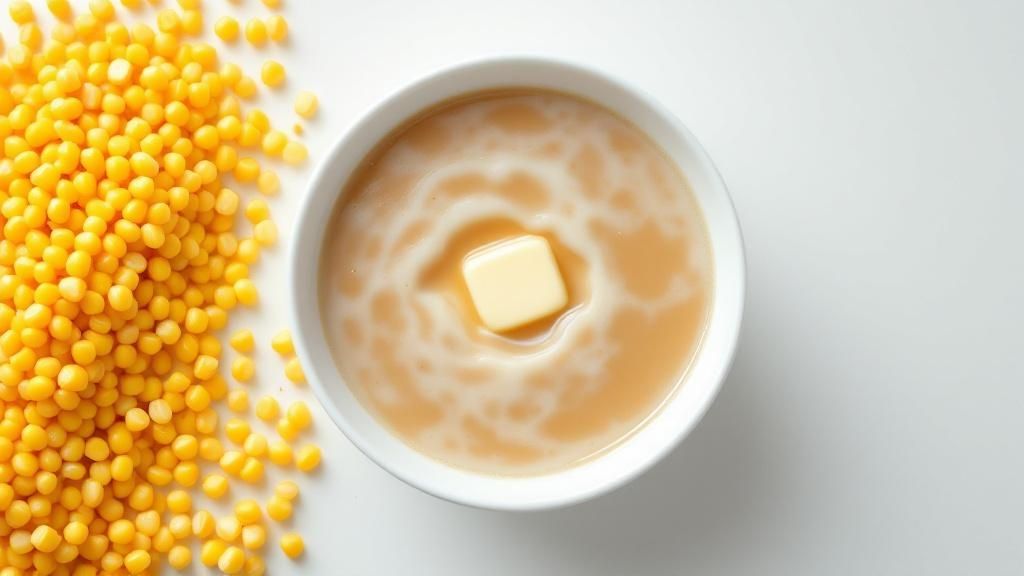
Questo stile offre un potente colpo di umami che è sia soddisfacente che profondamente confortante, rendendolo uno dei tipi di ramen più amati in Giappone e all'estero. Il carattere complesso del brodo deriva dal miso stesso, una pietra miliare della cucina giapponese. Per chi desidera incorporare questo ingrediente sano e saporito nella propria cucina, può esaltare i propri piatti con pasta di miso a basso contenuto di sodio.
Caratteristiche chiave e condimenti
Il ramen miso è noto per i suoi sapori decisi e i condimenti sostanziosi che creano una ciotola abbondante e soddisfacente.
- Brodo: Opaco e denso, tipicamente fatto con un ricco brodo di maiale o pollo miscelato con una generosa quantità di pasta di miso. Il sapore è complesso, salato e saporito.
- Noodles: Spesso spessi, ondulati e gialli, con una consistenza molto soda e masticabile progettata per resistere al brodo potente.
- Condimenti comuni: Mais dolce, una noce di burro, germogli di soia saltati, carne di maiale macinata (soboro) e chashu sono aggiunte classiche, che riflettono le origini di Hokkaido.
Perché è un classico
Il viaggio del ramen miso da specialità regionale a fenomeno globale testimonia il suo incredibile sapore. Attribuito a Morito Omiya del Aji no Sanpei di Sapporo negli anni '50, questo stile ha rivoluzionato la scena del ramen introducendo il miso come condimento principale. La sua popolarità è esplosa, stabilendo Sapporo come una destinazione chiave per il ramen. La combinazione iconica di mais e burro completa perfettamente la sapidità del brodo, creando un gusto distintivo che è diventato sinonimo di autentico cibo comfort giapponese.
4. Ramen Shio
Il ramen shio è celebrato come il più leggero e delicato di tutti i tipi di ramen, mostrando un profilo di gusto puro e pulito. Considerato uno degli stili originali di ramen con possibili radici a Hakodate, Hokkaido, la sua caratteristica distintiva è un brodo chiaro e dorato pallido. Il nome stesso, "shio", significa sale, che è l'agente di condimento principale nel suo tare (salsa di condimento).
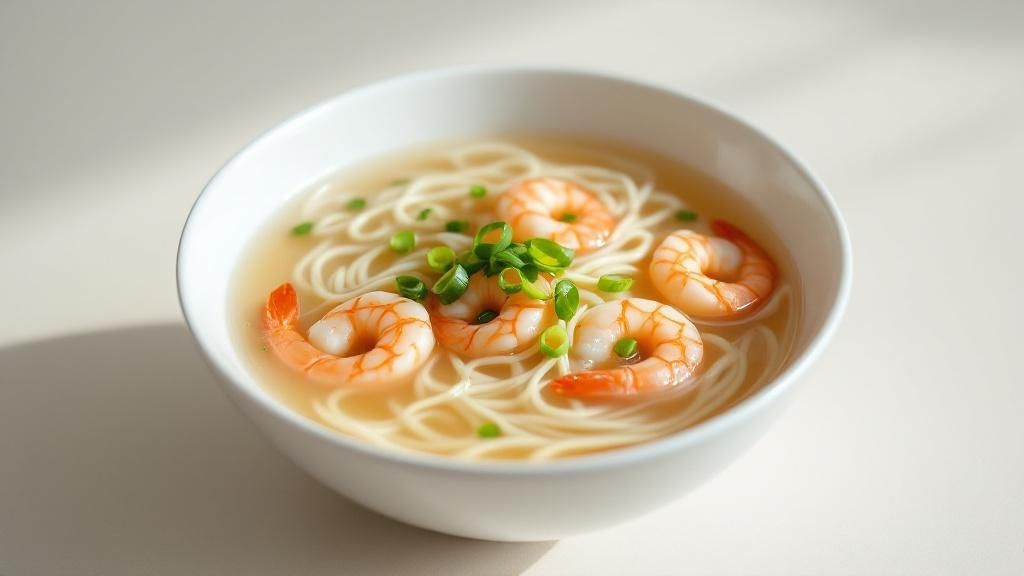
Questo approccio minimalista permette ai sapori intricati e naturali del brodo sottostante, spesso fatto con pollo, frutti di mare o dashi, di essere protagonisti. Il risultato è una ciotola elegante, sottile e rinfrescante, ingannevolmente complessa. Il suo sapore delicato la rende una scelta fantastica per chi apprezza gusti sfumati e vuole sperimentare la qualità fondamentale di un brodo di ramen ben fatto.
Caratteristiche chiave e condimenti
L'eleganza dello shio ramen è una testimonianza dell'idea che la semplicità possa portare alla perfezione, dove ogni ingrediente deve essere della massima qualità.
- Brodo: Chiaro, leggero e di colore pallido. È condito con un tare a base di sale che mette in risalto le note sottili del brodo di pollo, maiale o frutti di mare.
- Noodles: Tipicamente dritti e sottili, offrono una consistenza liscia che completa il brodo leggero senza sovrastarlo.
- Condimenti comuni: Fette di chashu (spesso pollo o maiale magro), menma (germogli di bambù), negi (porri o cipollotti), e talvolta frutti di mare come gamberi o capesante.
Perché è un classico
Lo shio ramen è un pilastro fondamentale tra i diversi tipi di ramen, incarnando una filosofia del "meno è più". La sua purezza lo rende una vera prova dell'abilità dello chef, poiché non ci sono sapori forti dietro cui nascondersi. Locali leggendari come Chukasoba Ginza Hachigo a Tokyo hanno elevato questo stile a nuovi livelli creando brodi con una profondità incredibile usando solo il sale come condimento. Per chiunque voglia apprezzare l'arte e l'equilibrio sottile della cucina giapponese, lo shio ramen offre un'esperienza raffinata e indimenticabile.
5. Tsukemen
Tsukemen reinventa fondamentalmente l'esperienza del ramen, scomponendo la ciotola classica nei suoi componenti essenziali. Spesso chiamato "ramen da intingere", questo stile è stato creato dal leggendario Kazuo Yamagishi negli anni '60. La sua caratteristica distintiva è la separazione tra noodles e brodo: noodles spessi e gommosi vengono serviti freddi o a temperatura ambiente insieme a una zuppa densa, calda e intensamente concentrata per intingere.
Questa separazione permette a ogni elemento di risplendere. I noodles mantengono la loro perfetta consistenza al dente senza diventare mollicci, e il commensale ha il controllo completo sull'intensità del sapore di ogni boccone. Il brodo è spesso una base ricca e complessa tonkotsu-gyokai (maiale e pesce), ridotta a creare una salsa potente e ricca di umami. Se sei ispirato a provare a prepararlo da solo, puoi esplorare alcune ricette giapponesi facili per iniziare.
Caratteristiche chiave e condimenti
Tsukemen è un pasto interattivo in cui l'equilibrio tra sapore e consistenza è fondamentale.
- Brodo: Una salsa per immersione estremamente ricca, densa e potente, spesso a base di maiale e pesce, servita calda.
- Tagliatelle: Più spesse e gommose rispetto alle tipiche tagliatelle da ramen, servite separatamente e spesso fredde o a temperatura ambiente.
- Condimenti comuni: Tipicamente serviti nella zuppa o a parte, includono chashu affettato, menma, un uovo morbido (ajitama) e talvolta una fetta di lime per tagliare la ricchezza.
Perché è un preferito moderno
Tsukemen offre un'esperienza sensoriale completamente diversa dal ramen tradizionale a base di zuppa, diventando un'ossessione moderna a Tokyo e oltre. Mette in risalto la qualità delle tagliatelle e offre un sapore potente e diretto. Negozi iconici come Rokurinsha e Fuunji attirano lunghe file di appassionati per le loro versioni magistrali. Alla fine del pasto, è consuetudine chiedere il soup-wari (brodo caldo dashi) per diluire la salsa rimanente in una zuppa deliziosa e bevibile, assicurando che nessuna goccia di sapore venga sprecata.
6. Tantanmen
Tantanmen offre una deviazione piccante e ricca dal ramen giapponese tradizionale, mostrando la potente influenza della cucina cinese del Sichuan. Questo stile è l'adattamento giapponese dei noodles dan dan, noti per il loro profilo di sapore audace, piccante e nocciolato. Il suo brodo è una miscela cremosa e complessa di pasta di sesamo (nerigoma), latte di soia o brodo, e un potente olio di peperoncino (rayu), creando una zuppa sia indulgente che rinvigorente.
Questo ramen fusion offre una sinfonia di sensazioni, dalla consistenza cremosa del sesamo al calore pungente del pepe di Sichuan. Si distingue tra i diversi tipi di ramen per il suo gusto unicamente stimolante. Per apprezzarne appieno la profondità, è meglio mescolare tutti gli ingredienti prima di prendere il primo sorso. Puoi esplorare di più su Tantanmen e altre entusiasmanti varianti di ramen nella nostra guida dettagliata.
Caratteristiche chiave e condimenti
Il fascino del Tantanmen risiede nella sua dinamica combinazione di elementi piccanti, saporiti e nocciolati, che lo rendono un'esperienza di ramen indimenticabile.
- Brodo: Opaco e cremoso, con una tonalità rosso-arancione dovuta all'olio di peperoncino. La base è una ricca miscela di pasta di sesamo, brodo e talvolta latte di soia, infusa con olio di peperoncino piccante e carne macinata.
- Tagliatelle: Spesso leggermente più spesse e ondulate per catturare efficacemente il brodo sostanzioso e i condimenti.
- Condimenti comuni: Maiale macinato piccante (niku miso), bok choy o altre verdure a foglia, arachidi tritate, cipollotti e un filo di olio al peperoncino extra.
Perché è un classico
Tantanmen si è ritagliato un posto amato nel mondo del ramen offrendo un profilo di sapore nettamente diverso dai suoi omologhi giapponesi. Reso popolare dai ristoranti cinese-giapponesi e da catene specializzate come il famoso Kikanbo di Tokyo, è diventato un classico moderno. Il suo successo dimostra l'incredibile capacità del ramen di evolversi e fondersi. Per chi desidera calore e complessità, Tantanmen offre un'alternativa profondamente soddisfacente ed entusiasmante alle ciotole più tradizionali.
7. Mazesoba
Mazesoba ridefinisce audacemente il ramen eliminando il brodo, offrendo un'esperienza di sapore intensamente concentrata. Il nome stesso si traduce in "noodles mescolati", che descrive perfettamente come viene mangiato. Originario di Nagoya e diventato popolare modernamente a Tokyo, questo stile presenta noodles spessi e gommosi serviti con un ricco e saporito tare (salsa) sul fondo della ciotola, guarniti con un vivace assortimento di ingredienti.
A differenza del ramen tradizionale dove il brodo è un componente chiave, Mazesoba pone tutta l'enfasi sull'interazione diretta tra noodles, salsa e condimenti. Questo crea un piatto potente e multilivello dove ogni boccone è una miscela dinamica di texture e sapori. L'esperienza è altamente interattiva, poiché devi mescolare tutti gli elementi insieme accuratamente per creare una salsa cremosa ed emulsionata che avvolge ogni filo di noodle.
Caratteristiche chiave e condimenti
Mazesoba è tutta una sinfonia di sapori audaci e texture varie che si uniscono in una singola ciotola.
- Brodo: Nessuno. La "zuppa" è una salsa densa e concentrata, spesso a base di soia con oli saporiti come olio di peperoncino o olio d'aglio.
- Noodles: Tipicamente molto spessi, robusti e gommosi per resistere alla vigorosa miscelazione e ai condimenti pesanti.
- Condimenti comuni: carne di maiale o manzo tritata piccante, un tuorlo d'uovo crudo, cipolle verdi tritate, nori (alghe essiccate), erba cipollina e generose quantità di aglio tritato.
Perché è un preferito moderno
Mazesoba rappresenta lo spirito innovativo e in evoluzione del mondo del ramen. Rompe con la tradizione per offrire un pasto unicamente soddisfacente e personalizzabile. La sua popolarità è stata spinta da innovatori contemporanei del ramen e negozi come Bassanova, che sperimentano combinazioni di sapori creative. La natura interattiva di mescolare gli ingredienti da soli, spesso completata con un tuorlo d'uovo crudo per una cremosità estrema, lo rende un piatto entusiasmante e memorabile che si distingue tra i molti tipi di ramen.
8. Ramen Kitakata
Originario della città di Kitakata nella prefettura di Fukushima, il ramen Kitakata è una specialità regionale amata, celebrata per i suoi sapori delicati e i suoi noodles distintivi. Questo stile è così radicato nella cultura locale che Kitakata vanta uno dei più alti numeri di negozi di ramen pro capite in Giappone. Il brodo è tipicamente leggero e pulito, spesso una miscela di brodo di ossa di maiale con niboshi (sardine essiccate) e una sottile speziatura di salsa di soia, creando una zuppa delicata ma profondamente soddisfacente.
A differenza dei tipi di ramen più audaci e corposi, il ramen Kitakata offre un'esperienza sfumata e confortante che mette in risalto la qualità dei suoi componenti principali, in particolare i suoi noodles unici. È un vero assaggio del cibo dell'anima tradizionale e regionale giapponese. A Kitakata è così popolare che i locali lo gustano famosamente a colazione, una tradizione nota come asa-ra (ramen mattutino).
Caratteristiche chiave e condimenti
La caratteristica distintiva del ramen Kitakata sono le sue tagliatelle speciali, che creano una texture e una sensazione in bocca deliziose.
- Brodo: Una zuppa chiara, di colore dorato chiaro, fatta con ossa di maiale e niboshi, condita con un delicato tare shoyu. È meno salata e oleosa rispetto a molti altri stili.
- Tagliatelle: Spesse, piatte e molto ricce, con un alto contenuto d'acqua. Queste tagliatelle hirauchi jukusei takasuimen sono morbide ma piacevolmente gommose.
- Condimenti comuni: Fette di tenero chashu (spesso un taglio più magro), menma (germogli di bambù) e una generosa quantità di cipollotti tritati.
Perché è un classico
Il ramen Kitakata rappresenta il cuore della cultura regionale del ramen. La sua ampia adorazione locale ha trasformato la città di Kitakata in un luogo di pellegrinaggio per gli amanti del ramen, consolidando il suo status come uno dei "Tre Grandi" stili regionali di ramen del Giappone, insieme a Sapporo e Hakata. Negozi famosi come Ban'nai Shokudo hanno contribuito a far conoscere questo stile a un pubblico più ampio, mostrando i suoi sapori semplici e puri. Per chiunque esplori il mondo variegato della cucina regionale giapponese, il ramen Kitakata è un'esperienza essenziale e autentica.
9. Abura Soba
Abura Soba, spesso chiamato "tagliatelle all'olio", è uno stile unico e sempre più popolare di ramen senza brodo che mette le tagliatelle al centro dell'attenzione. Originario di Tokyo negli anni '50, il suo nome si traduce in "tagliatelle all'olio", che descrive accuratamente il suo concetto principale: tagliatelle condite con un ricco e saporito tare (salsa di condimento) e olio profumato invece di essere immerse nella zuppa. Questo metodo di preparazione offre un'esplosione di sapore intensa e concentrata.
Questo stile offre un'esperienza testurale completamente diversa, enfatizzando la masticabilità delle tagliatelle ricoperte da una salsa saporita. È un piatto sostanzioso e soddisfacente che dimostra che non serve sempre il brodo per creare uno dei tipi di ramen più coinvolgenti. Il suo profilo di gusto diretto e potente lo ha reso un favorito moderno.
Caratteristiche chiave e condimenti
Il fascino dell'Abura Soba risiede nella sua diretta espressione di sapore e nell'esperienza interattiva di mescolare insieme gli ingredienti.
- Brodo: Nessuno. La "zuppa" è una base saporita di olio (spesso infuso con aromi) e un tare a base di soia che si deposita sul fondo della ciotola.
- Tagliatelle: Tagliatelle spesse, gommose e ondulate sono standard, poiché la loro consistenza robusta è essenziale per il carattere del piatto.
- Condimenti comuni: Maiale chashu a dadini, menma (germogli di bambù), cipollotti tritati, nori (alghe) sminuzzate e spesso un tuorlo d'uovo crudo o morbido per aggiungere cremosità. Rayu (olio al peperoncino) e aceto sono quasi sempre forniti a parte per la personalizzazione.
Perché è un classico
Abura Soba è una testimonianza dell'evoluzione continua del ramen. Mentre Chinchintei a Tokyo è spesso accreditato per la sua popolarizzazione, le moderne ramen-ya lo hanno adottato come tela per la creatività. L'istruzione chiave per i commensali è mescolare tutto accuratamente prima del primo boccone, assicurandosi che ogni noodle sia ricoperto di salsa, olio e condimenti. È una scelta perfetta per chi ama la consistenza dei noodles e desidera un'esperienza umami potente e diretta senza il peso di una ciotola piena di brodo.
Confronto di 9 Tipi di Ramen
| Stile Ramen | Complessità di implementazione 504 | Requisiti di risorse ⚡ | Risultati attesi 4CA | Casi d'uso ideali 4A1 | Vantaggi chiave ⭐ |
|---|---|---|---|---|---|
| Shoyu Ramen | Medio - bilanciamento esperto del tare | Moderato - salsa di soia di qualità, brodo | Brodo pulito, ricco di umami, leggero | Amanti del ramen tradizionale, condimenti versatili | Leggero, digeribile, umami autentico |
| Tonkotsu Ramen | Alto - lunga bollitura (12-20 ore) | Alto - ossa di maiale, cottura prolungata | Ricco, cremoso, sostanzioso, intensamente saporito | Pasti sostanziosi, amanti del cibo confortante | Sapore profondo, estremamente soddisfacente |
| Miso Ramen | Medio - gestione della pasta fermentata | Moderato - miso, condimenti come mais, burro | Robusto, saporito, complesso, riscaldante | Climi freddi, pasti ricchi e sostanziosi | Ricco di probiotici, saziante, saporito |
| Shio Ramen | Medio - equilibrio delicato richiesto | Moderato - brodo di alta qualità | Brodo leggero, pulito e rinfrescante | Preferenza per ramen elegante e minimalista | Mette in risalto gli ingredienti, sapore leggero |
| Tsukemen | Alto - preparazione separata di brodo e pasta | Da moderato a alto - brodo concentrato | Sapore intenso, contrasto di consistenze | Cena interattiva, amanti dei sapori intensi | Consistenza della pasta mantenuta, personalizzabile |
| Tantanmen | Medio - equilibrio tra spezie e sesamo | Moderato - pasta di sesamo, peperoncino | Brodo ricco, cremoso, piccante e nocciolato | Appassionati di cucina fusion, amanti delle spezie | Sapore unico di nocciola, spezie soddisfacenti |
| Mazesoba | Da basso a medio - senza brodo, da mescolare | Basso - salsa, condimenti | Sapori intensi e concentrati, noodles gommosi | Preferenza per ramen senza brodo, pasti veloci | Sapore concentrato, personalizzabile |
| Ramen Kitakata | Medio - metodi tradizionali | Moderato - shoyu leggero, noodles piatti | Sapore leggero, delicato e chiaro | Specialità regionale, opzione per la colazione | Texture unica del noodle, autentico |
| Abura Soba | Basso - semplice miscela di olio e aceto | Basso - oli, aceto | Sapore ricco, oleoso e concentrato del noodle | Pasti veloci, appassionati di noodles all'olio | Sapore puro del noodle, rapido da preparare |
La tua prossima ciotola ti aspetta: trovare il ramen perfetto per te
Abbiamo esplorato il ricco e variegato panorama del ramen, viaggiando dalla profondità del Tonkotsu in stile Hakata a base di ossa di maiale alla leggerezza e chiarezza sfumata dello Shio. Hai scoperto le profondità audaci e saporite del ramen Miso, l'eleganza fondamentale della salsa di soia dello Shoyu e l'esperienza unica e interattiva del Tsukemen. La nostra esplorazione non si è fermata qui; ci siamo immersi nel mondo piccante e nocciolato del Tantanmen, nell'intensità senza brodo di Mazesoba e Abura Soba, e nel fascino regionale dei larghi e ricci noodles di Kitakata.
Questa guida ti ha fornito più di semplici nomi e ingredienti; è un passaporto per un mondo di scoperta culinaria. Comprendere i componenti fondamentali di ciascuno di questi tipi di ramen ti permette di entrare in qualsiasi ramen-ya, sia a Tokyo che nella tua città, e ordinare con sicurezza, sapendo esattamente cosa aspettarti.
Dalla Conoscenza all'Azione: Il Tuo Viaggio nel Ramen Inizia
La vera avventura inizia ora. La prossima volta che sentirai il desiderio di un pasto profondamente soddisfacente, non pensare solo a "ramen." Pensa a ciò che desideri veramente.
- Per un'esperienza confortante e ricca: Una ciotola cremosa di Tonkotsu è la tua risposta. Il suo brodo di maiale emulsionato avvolge ogni noodle e offre una profondità di sapore senza pari, perfetta per una giornata fredda o piovosa.
- Per un pasto leggero ma saporito: Opta per il ramen Shio. La sua delicatezza a base di sale permette alle note sottili di pollo, frutti di mare e dashi di emergere senza appesantirti.
- Per una ciotola audace e sostanziosa: Il ramen Miso offre una sapidità complessa e fermentata che fornisce un senso di comfort food unicamente giapponese. Sperimenta con diversi tipi di miso, dal bianco (shiro) al rosso (aka), per trovare l'intensità che preferisci.
- Per un sapore interattivo e concentrato: Il formato scomposto del Tsukemen è da provare assolutamente. Intingere noodles spessi e gommosi in un brodo potente e ricco di sapore ti mette al controllo di ogni singolo boccone.
Questa conoscenza ti trasforma da consumatore passivo a partecipante attivo. Ora puoi apprezzare l'arte dietro un brodo Shoyu perfettamente bilanciato o il genio testurale dei condimenti in una ciotola di Mazesoba.
La Conclusione Fondamentale: Il Ramen è un'Espressione Personale
In definitiva, la cosa più importante da ricordare è che non esiste un unico tipo di ramen "migliore". La ciotola perfetta è del tutto soggettiva e situazionale. Il tuo preferito potrebbe essere un Tantanmen piccante di venerdì sera e un semplice ramen Kitakata per un pranzo tranquillo infrasettimanale. La bellezza di questo iconico piatto giapponese risiede nella sua incredibile versatilità.
Il tuo viaggio non deve limitarsi ai ristoranti. Portare questi sapori autentici nella tua cucina è un passo successivo profondamente gratificante. Comprendendo i mattoni fondamentali di ogni stile di ramen, puoi iniziare a sperimentare a casa. Immagina di preparare il tuo chashu, marinare un perfetto ajitama o persino miscelare il tuo miso tare. Le possibilità sono davvero infinite, e questa guida è la tua base fondamentale per quel processo creativo. La tua prossima ciotola di ramen preferita ti aspetta, sia in un negozio locale che nella tua stessa cucina.
Pronto a portare il gusto autentico del Giappone nella tua casa? Per dashi premium, salse di soia artigianali, paste di miso speciali e noodles di alta qualità, esplora la selezione curata su Buy Me Japan. Eleva le tue creazioni fatte in casa da pasti semplici a esperienze culinarie indimenticabili con gli ingredienti migliori provenienti direttamente dal Giappone.
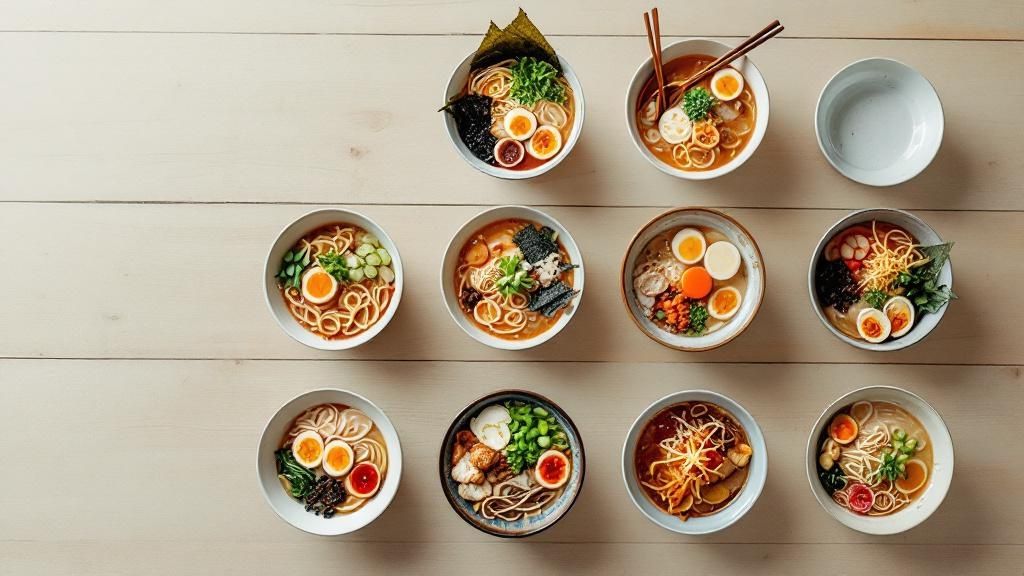



Compartir:
12 Migliori Marchi di Tè Giapponese per un Sorso Autentico nel 2025
7 Migliori Posti per Comprare Caramelle Giapponesi Milky Online (2025)